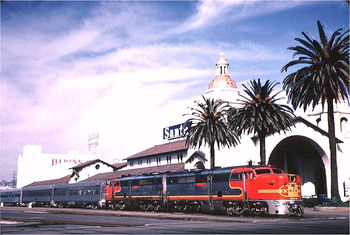CZ:Featured article/Current: Difference between revisions
imported>Chunbum Park (William Morris) |
imported>Chunbum Park (→William Morris: San Diegan) |
||
| Line 1: | Line 1: | ||
== '''[[ | == '''[[San Diegan]]''' == | ||
---- | ---- | ||
''' | [[Image:ATSF 64 at San Diego CA 10-26-63.jpg|thumb|350px|right|{{ATSF 64 at San Diego CA 10-26-63.jpg/credit}}<br />The ''San Diegan'', led by a pair of back-to-back ALCO PA units, reaches the end of the line at San Diego's Union Station on October 26, 1963. The facility, constructed in the [[Mission Revival Style architecture|Mission Revival Style]] in support of the [[Panama-California Exposition]], officially opened on March 18, 1915.]] | ||
The '''''San Diegan''''' was one of the named passenger trains of the [[Atchison, Topeka and Santa Fe Railway]] (AT&SF). A true "workhorse" of the railroad, its 126-mile (203-kilometer) route ran from [[Los Angeles, California]] south to [[San Diego]]. It was assigned train Nos. 70–79 (Nos. 80–83 were added in 1952 when Budd Rail Diesel Car [RDCs] began operating on the line). The Los Angeles-San Diego corridor (popularly known as the "[[Surf Line]]" — officially, the Fourth District of the Los Angeles Division) was to the Santa Fe as the [[New York]]–[[Philadelphia]] corridor was to the [[Pennsylvania Railroad]]. Daily traffic could reach a density of ten trains (each way) during the summer months. The first ''San Diegan'' ran on March 27, 1938 as one set of equipment making two round trips each way. A second trainset delivered in 1941 made possible four streamlined trains each way. In addition, a third set of heavyweight equipment made a fifth trip in each direction.During and after the [[World War II|Second World War]], furlough business from San Diego's military bases necessitated extra (albeit heavyweight) sections of ''San Diegans'', and racetrack specials during horse racing season at [[Del Mar, California|Del Mar]] added to passenger train miles. [[Amtrak]] continued to operate the ''San Diegan'' when it took over operation of the nation's passenger service on May 1, 1971, ultimately retiring the name on June 1, 2001. Today the route of the ''San Diegan'' (the second busiest rail line in the [[United States]]) is served by Amtrak's ''[[Pacific Surfliner]]''. | |||
''[[San Diegan|.... (read more)]]'' | |||
''[[ | |||
{| class="wikitable collapsible collapsed" style="width: 90%; float: center; margin: 0.5em 1em 0.8em 0px;" | {| class="wikitable collapsible collapsed" style="width: 90%; float: center; margin: 0.5em 1em 0.8em 0px;" | ||
|- | |- | ||
! style="text-align: center;" | [[ | ! style="text-align: center;" | [[San Diegan#Notes|notes]] | ||
|- | |- | ||
| | | | ||
{{reflist|2}} | {{reflist|2}} | ||
|} | |} | ||
Revision as of 21:52, 10 August 2013
San Diegan

The San Diegan, led by a pair of back-to-back ALCO PA units, reaches the end of the line at San Diego's Union Station on October 26, 1963. The facility, constructed in the Mission Revival Style in support of the Panama-California Exposition, officially opened on March 18, 1915.
The San Diegan was one of the named passenger trains of the Atchison, Topeka and Santa Fe Railway (AT&SF). A true "workhorse" of the railroad, its 126-mile (203-kilometer) route ran from Los Angeles, California south to San Diego. It was assigned train Nos. 70–79 (Nos. 80–83 were added in 1952 when Budd Rail Diesel Car [RDCs] began operating on the line). The Los Angeles-San Diego corridor (popularly known as the "Surf Line" — officially, the Fourth District of the Los Angeles Division) was to the Santa Fe as the New York–Philadelphia corridor was to the Pennsylvania Railroad. Daily traffic could reach a density of ten trains (each way) during the summer months. The first San Diegan ran on March 27, 1938 as one set of equipment making two round trips each way. A second trainset delivered in 1941 made possible four streamlined trains each way. In addition, a third set of heavyweight equipment made a fifth trip in each direction.During and after the Second World War, furlough business from San Diego's military bases necessitated extra (albeit heavyweight) sections of San Diegans, and racetrack specials during horse racing season at Del Mar added to passenger train miles. Amtrak continued to operate the San Diegan when it took over operation of the nation's passenger service on May 1, 1971, ultimately retiring the name on June 1, 2001. Today the route of the San Diegan (the second busiest rail line in the United States) is served by Amtrak's Pacific Surfliner.
| notes |
|---|